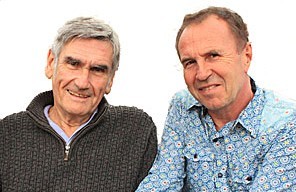Non-violent communication according to Marshal B. Rosenberg
?Wenn ich a sehe, dann fühle ich b, weil ich c brauche.
Marshal B. Rosenberg
Deshalb möchte ich jetzt gerne d.?
Die Gewaltfreie Kommunikation (GFK) ist ein Konzept, das von Marshall B. Rosenberg entwickelt wurde. Es soll Menschen ermöglichen, so miteinander umzugehen, dass der Kommunikationsfluss zu mehr Vertrauen und Freude am Leben führt. GFK kann in diesem Sinne sowohl bei der Kommunikation im Alltag als auch bei der friedlichen Konfliktlösung im persönlichen, beruflichen oder politischen Bereich hilfreich sein. Im Vordergrund steht nicht, andere Menschen zu einem bestimmten Handeln zu bewegen, sondern eine wertschätzende Beziehung zu entwickeln, die mehr Kooperation und gemeinsame Kreativität im Zusammenleben ermöglicht. Manchmal werden auch die Bezeichnungen ?Einfühlsame Kommunikation?, ?Verbindende Kommunikation?, ?Sprache des Herzens? oder ?Giraffensprache? verwendet.
Assumptions of NVC
Die vier Schritte der GFK sind Beobachtung, Gefühl, Bedürfnis, Bitte:
- Beobachtung bedeutet, eine konkrete Handlung (oder Unterlassung) zu beschreiben, ohne sie mit einer Bewertung oder Interpretation zu vermischen. Es geht hierbei darum, nicht zu bewerten, sondern die Bewertung von der Beobachtung zu trennen, so dass das Gegenüber Bescheid weiß, worauf man sich bezieht.
- Die Beobachtung löst ein Gefühl aus, das im Körper wahrnehmbar ist und mit mehreren oder einem ?
- Bedürfnis in Verbindung steht. Damit sind allgemeine Qualitäten gemeint, die vermutlich jeder Mensch auf Erden gerne in seinem Leben hätte, wie zum Beispiel Sicherheit, Verständnis, Kontakt oder Sinn. Gefühle sind laut GFK Ausdruck dessen, ob ein Bedürfnis gerade erfüllt ist oder nicht, eine Art Indikator. Für den einfühlsamen Kontakt sind Bedürfnisse sehr wichtig, da sie den Weg zu einer kreativen Lösung weisen, die für alle Beteiligten passt.
- Aus dem Bedürfnis geht schließlich eine Bitte um eine konkrete Handlung im Hier und Jetzt hervor. Um sie möglichst erfüllbar zu machen, lassen sich Bitten und Wünsche unterscheiden: Bitten beziehen sich auf Handlungen im Jetzt, Wünsche dagegen sind vager, beziehen sich auf Zustände (?sei respektvoll?) oder auf Ereignisse in der Zukunft. Erstere sind leichter zu erfüllen, haben deshalb auch mehr Chancen auf Erfolg. Rosenberg schlägt außerdem vor, Bitten in einer ?positiven Handlungssprache? zu formulieren ? sprich, zu sagen, was man will, statt was man nicht will. Man kann unterscheiden zwischen einer Handlungsbitte (beispielsweise darum, die Geschirrspülmaschine auszuräumen) und einer Beziehungsbitte (beispielsweise um eine Beschreibung der eigenen Empfindungen).
Auch als Haltung für das empathische Zuhören empfiehlt Rosenberg, aus dem, was der andere sagt, diese vier Informationen herauszufiltern, da sie in der Regel das Herz der Botschaft darstellen. Zur Überprüfung, ob seine Deutung stimmt, kann der Zuhörende anbieten, was er in Form der vier Schritte hört (?Fühlst du ?, weil dir ? wichtig ist??). Das kann auch hilfreich sein, wenn der Sprecher durch dieses Spiegeln selber mehr Klarheit darüber gewinnt, was er eigentlich ausdrücken will. Das ausgesprochene und stille empathische Zuhören ist ein wesentlicher Aspekt der Anwendung von GFK.
Das formale Grundmodell ist nach Rosenberg eine Art Übergangshilfe für die mindfulness training nicht jedoch ein Ersatz für die Alltagssprache. Man braucht in der Regel erhebliche Übung, bis die GFK in der Alltagssprache zu einer flüssigen Kommunikation wird.
Wenn eine Problemlösung im Gespräch nicht möglich ist und zur Setzung von Grenzen, spricht Rosenberg von der schützenden Anwendung von Macht, die er von der strafenden Anwendung unterscheidet. Während letztere den Fokus hat, menschliches Verhalten auf Basis von Selbsthass zu ändern, geht es bei ersterer darum, weitere Verletzungen zu verhindern und für Schutz zu sorgen, aus dem heraus überhaupt erst wieder die Bereitschaft entstehen kann, erneut in Kontakt zu treten.
Wertemanufaktur arbeitet u.a. mit der österreichischen Unternehmensberatung B2B-Empathy and Mag. Peter Pressnitz.
